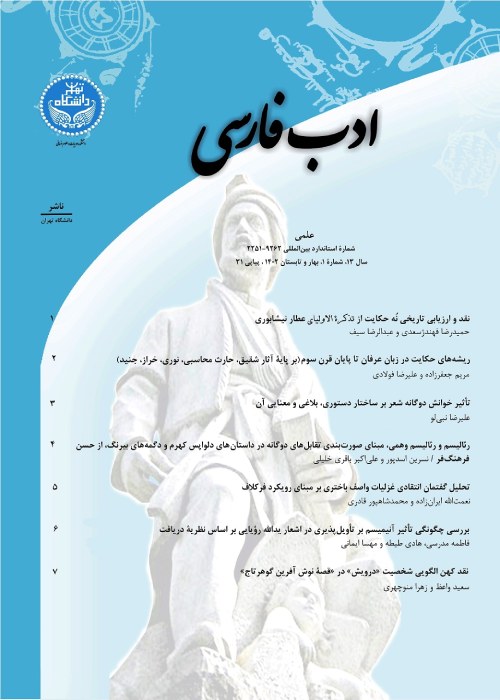A Study and Comparison of Common Anecdotes in Attar's Asrarnameh and Tazkirat al-Awliya
One of the most common techniques in the works of Persian language poets is to turn prose stories into poetry, especially mystical stories and sayings. In this regard, Attar Neishaburi has a prominent position among poets. In order to create his valuable masnavis, Attar took a lot of inspiration from Tazkirat al-Awliya, which is apparently the result of his studies in the sources of Sufism during his youth. One of these masnavis is called Asrarnameh. Asrarnameh is the shortest masnavi of Attar Neishaburi. This Masnavi in the latest critical edition has eighteen sections and a total of 3307 verses. Tazkirat al-Awliya contains stories and sayings of ninety-seven of the most prominent Islamic ascetics and mystics. The Tazkira al-Awliyai that we have today consists of two parts, the first part of which has been attributed to Attar Neishaburi from the past until now, and the second part of which, according to the majority of researchers, cannot be from Attar and is probably added by anonymous authors or scribes. This article is an attempt to explain the commonalities of the content of Tazkirat al-Awliya and masnavis of Attar Neishabouri, which has specially reread and adapted the common anecdotes of Asrarnameh and Tazkirat al-Awliya. The authors studied and compared the two recent works with the motivation to better understand how the masterpieces of the Persian language were created; With the aim of providing quantitative and qualitative statistics of the details of the comparative examples and after giving an introduction about these two books, they have shown that Attâr took at least fifteen anecdotes from Tazkirat Al-Awliyâ to create Asrârnâmeh and regardless of minor additions and deletions, he has been faithful to the core of the narrative in most cases. Most of the anecdotes are related to Bayazid Bastami. The anecdotes under study are used to simplify and express mystical concepts such as demand (Talab), poverty (Faghr) bad ending (Sou al-’Aghebat), consent (Reza), sacrifice (’Isar), unworldliness (Tark-e Ta’alloghat-e maddi), self-purification (Tahzib-e Nafs) and unity of being (Vahdat-e Vojoud). Among them, "unity of being" is the most repeated. Studying the biographies of the characters in these stories, such as Bayazid, Shibli, and Abulhasan Bornouzi, shows that in the cases that Attar took from Tazkirat al-Awliya, he was more interested in the stories of mystics who were inclined to Sokr. We also found that in the majority of these fifteen anecdotes that Attar arranged, he was faithful to the text of Tazkirat al-Awliya and preserved the core of the anecdotes with full skill and elegance. The minor additions and deletions that he included in the verse forms were only to maintain brevity, prosodic limitations and literary attractiveness enhancement or explanation and interpretation of the text.
- حق عضویت دریافتی صرف حمایت از نشریات عضو و نگهداری، تکمیل و توسعه مگیران میشود.
- پرداخت حق اشتراک و دانلود مقالات اجازه بازنشر آن در سایر رسانههای چاپی و دیجیتال را به کاربر نمیدهد.



